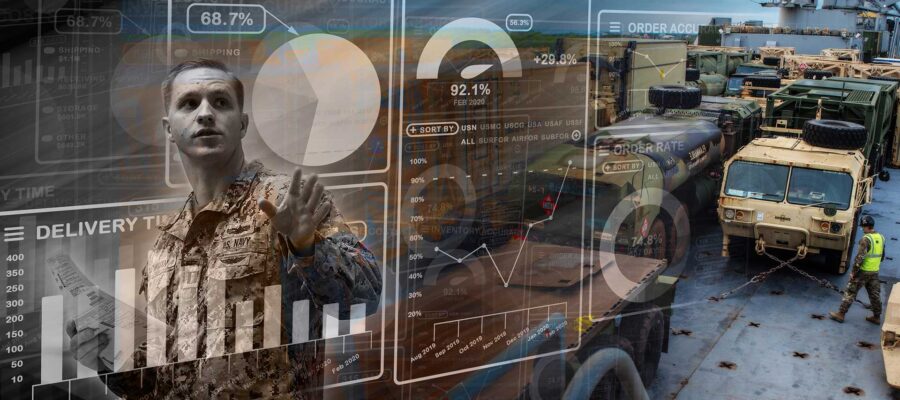This post has already been read 6462 times!
How a digital supply chain network improves functionality, reduces staffing and support, and provides a comprehensive platform for defense supply chain management at lower cost
In my previous article, Essential Capabilities of Joint Transportation Management Systems for Defense Organizations, I covered what organizations should look for in a JTMS. In this article, we will go deeper and look at what that looks like in detail, using One Network’s platform, and starting with the basics and moving up to the more advanced capabilities.
Level 1: End-to-End and Real-Time Logistics Visibility
To successfully represent the complete logistics lifecycle across a network of supply chain participants (warehouses, manufacturers, suppliers, transportation providers, and numerous locations), One Network’s Logistics Control Tower serves as a system of engagement, integrating and harmonizing data across internal and external players.
It also can embrace legacy systems and assume control of any point in the shipment execution lifecycle as needed. By integrating transaction information across all parties, the Control Tower solution enables real-time visibility of the entire logistics lifecycle, from purchase orders, shipment orders, shipment executions, track and trace, and financial settlements.
"An effective Joint Transportation Management System (JTMS) for defense organizations should embrace legacy systems and provide real-time visibility across the entire logistics lifecycle…" -Michael Bruens Share on XIntegrating with multiple legacy systems and unifying operations with many of today’s private sector systems will exponentially increase synergy across the entire Joint Deployment and Distribution Enterprise (JDDE). This solution will drive efficiencies throughout defense organizations (such as USTRANSCOM and its Service components) that are not realized today.
The solution has the following capabilities:
- Multi-modal execution with distinct assignments and control
- Integrated process flows
- Milestone settings and management based on expected arrival/departure times
- Tracking Customs Submissions, Customs Hold and Clearance events
- Chain-of-Custody with serialization
- Global trade compliance
- Supply and finish goods condition tracking (for example: temperature, expiration)
- Container management
- Telematics Integration
Level 2: Supply Chain Performance Measurement, Predictive Analytics, and Event Management
End-to-end visibility is further supported by robust permission and dashboarding configuration that allows all participants to view in real-time and analyze only the data relevant to their organization and user role. This feature assists organizations like USTRANSCOM to more effectively and efficiently manage its Service components and gives the DPO the ability to anticipate requirements better than ever.
- Operational dashboards are configurable at the user level and include all tasks and alerts and predicted issues relevant to each specific role. Users can drill into each task, review alerts, and quickly resolve issues using these operational dashboards.
- Command and control monitoring provides a management overview of the health of the network configurable to their unique perspective.
- Operational data views provide real-time visibility of transactions where users can build customized reports, leverage reporting templates, and create data cubes or pivot tables.
- Enterprise slicing allows users to easily export/import data into other operational or reporting tools
Level 3: Recommended Solutions, Case Management, and Prescriptive Workflows
By using a digital twin, the system continuously compares planned activities to actual activities to determine the likely impact, alert relevant parties of deviations, and provide recommended solutions so exceptions can be managed quickly and effectively.
The network-enabled Control Tower goes beyond what traditional Transportation Management System (TMS) can accomplish by allowing network participants to collaborate on time-sensitive issues in real-time. This feature enables organizations to collaborate through multiple tiers and parties to continue to improve the effectiveness and efficiency of the JDDE.
In addition, the case management, root cause analysis, and what-if capabilities enable shippers and logistics service providers to manage recurring issues that occur during the execution process.
Prescriptive workflows seamlessly incorporate warehouse, yard activities, and dock scheduling operations into the end-to-end logistics process.
Frequently managed processes across separate systems or by manual communication can be streamlined across all parties where specific roles, activities and performance metrics can be established for optimized operations.
In addition, Chain-of-Custody tracking enables enhanced tracking and tracing of products and ownership, aligned with industry standards, through the entire supply chain for complete visibility. This would include enhanced container management capability. It allows for immediate and efficient management of disputes and enables the handling of targeted recalls in a faster, simpler, and more precise manner.
Level 4: Autonomous Supply Chain Network Control
In the final level of maturity, many suggested resolutions and user-managed actions can be gradually converted to automated network actions. One Network’s autonomous NEO agents include advanced planning and optimization algorithms that drive tactical decision-making, such as placing a second supply order, executing a transportation move, or taking no actions. Other capabilities include transport capacity forecasting and transport optimization for dedicated and common carrier equipment as well as advanced scheduling.
"A Logistics Control Tower should go beyond detecting trends and automating issue resolution and can propose models to improve operational efficiencies." -Michael Bruens Share on XThe Logistics Control Tower goes beyond detecting trends and automating issue resolution and can propose models to improve operational efficiencies. Through increased automation and intelligent agents, the entire multi-party business network will be able to reduce manual tracking and support requirements to ultimately offer greater levels of service and value to the end customer. This capability enables organizations like USTRANSCOM to plan and manage all operations throughout all levels of the supply chain, becoming a true ubiquitous DPO, with omniscient oversight at all times, in real time.
This logistics solution empowers customers to drive the complete lifecycle of transportation processes with precision, including:
- Logistics planning, execution and management
- Procurement and contracting
- Carrier Services and appointment scheduling
- Yard management / Container management
- Global trade management
- Financial services and claims settlement support for accounts payable (AP) and accounts receivable (AR) invoices covering Freight Invoices and Client Invoices. It also enables:
- Transactional invoices as well as periodic batch invoicing
- Multi-currency, multi-line invoices, credit and supplemental invoices
- Automated invoice auditing based on invoicing policies configured along with thresholds of discrepancy
- Collaborative platform in resolving the holds and Invoice Approvals and Payment updates
- General ledger codes based on geographical regions and associating transactions to these codes
JTMS on a Digital Supply Chain Network
All indications are that the time to modernize is now.
The environment to do so is perfect. Global defense organizations like USTRANSCOM, and others deserves a modernized joint transportation management system (JTMS) where they can plan and execute on a single platform, and integrate and unify joint transportation operations across their defense arms.
However, such organizations need more than a modernized JTMS. They require a secure, cloud-based, horizontally and vertically integrated, multi-functional logistics network that connects everyone and allows planning, execution, visibility and actionability, along with financials and auditability to occur on one integrated, joint solution.
Using a digital supply chain network for JTMS drives the entire lifecycle of transportation processes with precision and integration. It includes supply-agnostic procurement, transportation-agnostic shipment planning and execution, container and warehouse management, yard management, appointment scheduling, real-time visibility execution and tracking, and world-class financial and claims visibility and settlements. This reduces the overall transportation costs on one single, secure, cloud-based platform. In addition, ONE’s NEO Platform that powers the Digital Supply Chain Network™ offers a unique Tunable System of Control that enables organizations to easily engage their legacy systems with the platform. It means that organizations can get a single version of the truth across multiple tiers and parties with the network, while empowering and leveraging legacy systems, to deliver optimal results.

Recommended Posts
- Are Micro Fulfillment Centers the Next Frontier in Retail Logistics?
- Rethinking Defense Supply Chains with Network-Based Command Centers
- How to Use Predictive Analytics to Streamline Cross-Border Logistics
- AI Plus Humans for Resilient Freight Forwarding in a Complex World
- Modern Defense Supply Chains: The Essential Capabilities for Multi-Domain Operations
